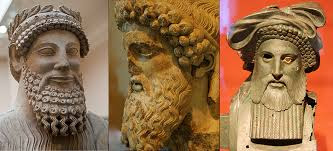Queen Victoria ruled England from 1837 to 1901.
Before this time, men were the focus of fashion, but with a
queen in power, women surged to the forefront. During the Victorian Era women
were seen as pure and clean whose bodies were considered temples which should
not be adorned with make-up. The role of a wife became to show off her husband’s status and wealth, the husband
receding to the background.
Many different clothing styles came and went during her
reign, namely:
Pre-Hoop Era 1840-1855/Hoop Era 1856-1869/Early Bustle
1869-1876/Natural Form 1877-1882/Late Bustle 1883-1889/Edwardian 1890’s.
Pre Hoop Era: In the 1840’s full skirts were supported by a
vast array of petticoats made of horsehair or stiffened with cane and padding.
The natural waist could be slightly longer than natural, with points in front
and behind. Most trimmings were applied to widen at the shoulder, narrowing at
the waist and again widening at the hem of the skirt to accentuate the tightly
laced waistline.
The bodice shoulder line ended well below the natural
shoulder, often pinning the arm of the wearer down. Day dresses had narrow
sleeves while evening bodices were often covered with folds of fabric or a
bertha.
In the 1850’s the sleeves started to become wider and skirts expanded
in size as more and more petticoats were worn. Added flounces on the skirt
helped create a wider look as dress fabrics were milled specially for flounces,
with colours and patterns were designed to be cut into strips. Daytime
necklines were more open and a ‘V’ neckline would be filled in over the bust by
a small chemisette.
Hoop Era: With the reinvention of the cage crinoline in 1856,
skirts were free to expand even farther. The round shaped hoop was somewhat
bustled behind, the skirts being made of straight widths of fabric v pleated
into a waistband. Bodice sleeves were full pagoda style, gathered at the
shoulder and full/split at the wrist with a linen undersleeve. The bodice for
casual attire now ended at the natural waist, straight all around, but the
formal the formal one often had two long points at the front and 1 or 3 long
points in the back.
During the Civil
war, hardships caused a decline in amount of fabric and trimmings in dresses
and flounces disappeared. In 1864 the 2 piece coat sleeve tapered at the wrist
and widened at the elbow and the bodice ending at the waist become popular. In
1865 skirt widths started diminishing at the hips to almost fit the waist and
by 1867 skirt size reduced altogether. In 1868 skirt backs were cut in straight
breadths and in 1869 the hoop was replaced by the bustle.
Early Bustle: The bustle was a framework on which the skirt
was full in front and had even more fabric at the back. Overskirts became a
must, and if one was not worn, one could be simulated with trimmings. In 1870
most bodices ended at the natural waist. The overskirt would be fitted over the
bodice, showing a belt and often a large bow behind. A detached basque (a very
short overskirt) became fashionable. By 1873, bodices became longer and longer
and the polonaise was born. It was a bodice and overskirt in one garment.
In
1875 the bustle began to dwindle in size but excess fabric remained. Many
petticoats were worn to help keep the dress from trailing through the dirt. The
shoulder line of the bodice still extended slightly past the natural shoulder.
Natural Form: By 1877 the bustle had diminished to a small
pad or nothing at all. The bodice called the Cuirass became long and smooth
fitting over the hips.A tall, slim figure became fashionable. The skirt had tie
strings inside to hold the front close to the legs, leaving the back to flow
freely into a train.The detached overskirt lost flavor. Bodices were also more
on the shoulder than off. By 1879 the
fan skirt becomes the mode. Petticoats and even hoops were needed to hold the
‘fan’ in good shape. The bodice shoulder line moves up to natural shoulder
line. Neckline for day wear becomes more conservative, either high with a
collar or open in a small ‘V’. By 1880 skirts are very slim and the train
begins to disappear.
Late Bustle: In 1883 the bustle returned with vengeance.
Skirts remains slim in front but ballooned out over a bustle frame. Evening
dresses are often without sleeves. The back draperies are usually lifted high
into poufs. Soon poufs, swags and drapes become an art form in itself. The
daytime neckline becomes very high, with a collar. The sleeve gains fullness
near the shoulder, but remains fitted below.






















